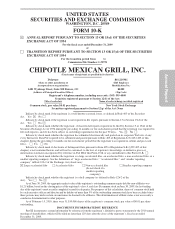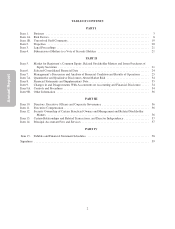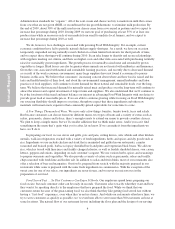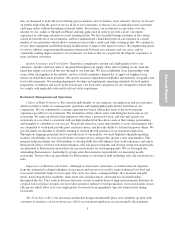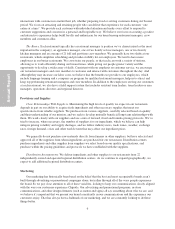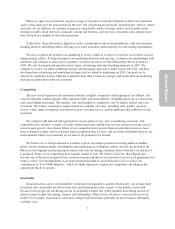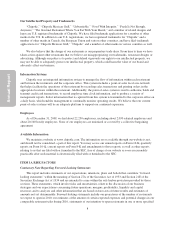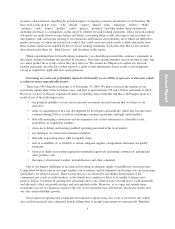Chipotle 2009 Annual Report Download - page 13
Download and view the complete annual report
Please find page 13 of the 2009 Chipotle annual report below. You can navigate through the pages in the report by either clicking on the pages listed below, or by using the keyword search tool below to find specific information within the annual report.
normalize. This is in part due to the time it takes to build a customer base in a new area, as well as to higher fixed
costs relating to increased labor and other start-up inefficiencies that are typical of new restaurants and a larger
proportion of our recent openings being in higher rent sites than we have historically targeted. If we are unable to
build the customer base that we expect for new restaurant locations or overcome the higher fixed costs associated
with new restaurant locations, new restaurants may not have similar results as our existing restaurants and may
not be profitable. We also have lowered the average development cost of our new restaurants significantly in
recent years, from $916,000 in 2008 to $850,000 in 2009, and expect additional decreases in 2010. In the event
we are not able to achieve the average development costs we expect for 2010 or sustain the benefits achieved in
prior years, which could result from inflation, project mismanagement or other reasons, our new restaurant
locations could also result in decreased profitability. In addition, our average restaurant sales declined and
comparable restaurant sales decelerated during 2009, and if these trends continue as a result of ongoing economic
uncertainty or otherwise, the ramp-up period for new restaurants may be longer, adversely impacting our overall
financial results. If for any of these reasons new restaurants do not perform as planned or adversely impact our
profitability, the price of our common stock is likely to decline.
In addition, we have now opened restaurants in nearly all major metropolitan areas across the U.S. New
restaurants opened in existing markets may adversely impact sales in previously-opened restaurants in the same
market as customers who frequent our established restaurants begin to visit a newly-opened restaurant instead.
This impact could worsen as we open additional restaurants, and could make it more difficult for us to increase
comparable restaurant sales and profitability. Existing restaurants could also make it more difficult to build the
customer base for newly-opened restaurants in the same market.
We plan to broaden our real estate selection strategy during 2010, which may result in lower new
restaurant sales volumes and potentially lower operating margins.
In 2010, as part of what we refer to as our “A Model” initiative, we plan to broaden the site selection criteria
we use to determine new restaurant locations, allowing us to open restaurants outside of the trade areas that we
have typically sought while still achieving our targeted economic returns. These trade areas may have lower
population densities or local traffic or less favorable demographic profiles than the trade areas we have typically
sought out for new locations. We expect that as many as 25% of our new restaurant openings will be in these
types of locations in 2010. This could adversely impact our operating margins notwithstanding the lower
development, occupancy and operational costs we expect for these locations. In addition, because we have less
experience opening restaurants in these types of trade areas there can be no assurance that restaurants opened in
these locations will generate the sales volumes we expect, and failure to reach those sales volumes would
adversely impact our profitability.
Changes in food and supply costs could adversely affect our results of operations.
Our profitability depends in part on our ability to anticipate and react to changes in food and supply costs. Like
all restaurant companies, we are susceptible to increases in food costs as a result of factors beyond our control, such
as general economic conditions, seasonal fluctuations, weather conditions, demand, food safety concerns,
generalized infectious diseases, fluctuations of the U.S. dollar, product recalls and government regulations. The cost
of many basic foods for humans and animals, including corn, wheat, rice and soy oil, has increased markedly in
some years, resulting in upward pricing pressures on almost all of our raw ingredients including chicken, beef,
tortillas and rice, increasing our food costs. Although the food price environment was generally favorable for us
during 2009, we expect that there may be pricing pressures on some of our key ingredients during 2010. We could
also be adversely impacted by price increases specific to naturally-raised meats or other food items we buy as part
of our Food With Integrity focus, the markets for which are generally smaller and more concentrated than the
markets for commodity food products. Any increase in the prices of the ingredients most critical to our menu, such
as beef, chicken, cheese, avocados, beans, rice, tomatoes and pork, would adversely affect our operating results.
Alternatively, in the event of cost increases with respect to one or more of our raw ingredients, we may choose to
suspend serving menu items, such as guacamole, rather than paying the increased cost for the ingredients. Any such
changes to our available menu may negatively impact our restaurant traffic and comparable restaurant sales.
11
Annual Report


